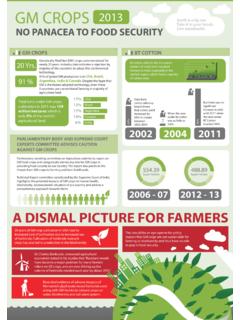Transcription of Fate of genetically modi ed maize and conventional ...
1 Author's personal copyORIGINAL INVESTIGATIONFate of genetically modified maize and conventional rapeseed , and endozoochory in wild boar (Susscrofa)Steffi Wiedemanna, , Bodo Lutza, Christiane Albrechta,b, Ralph Kuehnc,Berta Killermannd, Ralf Einspaniere, Heinrich MeyeraaPhysiology Weihenstephan, Technische Universita tMu nchen,Weihenstephaner Berg 3, 85354 Freising, GermanybInstitute of Biochemistry and Molecular Medicine, University of Bern, Buehlstr. 28, CH-3012 Bern, SwitzerlandcWildlife Biology and Wildlife Management Unit, Technische Universita tMu nchen, Am Hochanger 13, 85354 Freising, GermanydBavarian State Research Center for Agriculture, Lange Point 6, 85354 Freising, GermanyeInstitute of Veterinary Biochemistry, Free University Berlin, Oertzenweg 19b, 14163 Berlin, GermanyReceived 1 February 2008; accepted 1 July 2008 AbstractFeeding experiments were carried out to investigate the digestive fate of transgenic DNA and novel protein in wildboar applying polymerase chain reaction (PCR) and immunodiagnostic techniques.
2 Furthermore, the dispersal ofviable maize and rapeseed ( endozoochory ) was studied. A diet containing conventional rapeseed , and either geneticallymodified (GM) maize expressing Cry1Ab protein (Bt176) or non-GM isogenic maize was offered. By conventional andquantitative PCR both chloroplast-specific plant DNA (rubisco)andcry1 Abgene fragments were detected only ingastrointestinal content. Using an enzyme-linked immunosorbent assay (ELISA) positive signals of immunoactiveCry1Ab protein were detected in digesta samples. Analysis of endozoochory showed that excreted maize seeds retaintheir germination capacity only in extremely rare cases and no intact rapeseed was found in faeces. A possible dispersalof viable seeds by wild boars is highly Deutsche Gesellschaft fu rSa ugetierkunde. Published by Elsevier GmbH. All rights :Wild boar; Bt- maize ; endozoochory ; Recombinant DNA; Cry1Ab proteinIntroductionSince their commercial release in 1996, the global areaof genetically modified (GM) plants has increased from2 to 114 million ha including million ha GM maizeand million ha GM rapeseed (James 2007).
3 Themajority of GM crops currently planted, like maizeand rapeseed , have been engineered to enhance agro-nomic performance by transformation with genesencoding herbicide tolerance and/or pest , numerous detailed studies on GM livestockfeeding qualities, on nutritional evaluation and onstability and fate of recombinant DNA or proteinsconsumed by domestic animals, cattle, poultry andpigs have been reviewed (Flachowsky et al. 2005, 2007;Alexander et al. 2007). Studies conducted with pigs haveillustrated that plant-derived and recombinant DNA aswell as recombinant proteins are quickly degradedthroughout the digestive tract (Chowdhury et al. 2003;Jennings et al. 2003). However, currently scarceinformation is available about the impact of GM cropson wildlife et al. (2008)performedARTICLE IN $ - see front matterr2008 Deutsche Gesellschaft fu rSa ugetierkunde. Published by Elsevier GmbH. All rights biol. 74 (2009) 191 197 Corresponding author.
4 Tel.: +49 8161 71 4333;fax: +49 8161 71 (S. Wiedemann).Author's personal copyfeeding experiments ( maize event Bt176) with fallowdeer as an example for wild ruminants. They showed aclear fragmentation of multi-copy endogenous maizegenes throughout the digestive tract, but could notdetect neither recombinantcry1 AbDNA nor immu-noactive Cry1Ab protein in any tissue or gastrointest-inal (GI) content. Regardless of these findings, it can beassumed that monogastric game animals like wild boar(Sus scrofa) consuming GM plants potentially contri-bute to the dispersal of transgenic DNA, novel proteinand viable seeds into areas growing conventional this context it should be mentioned that home rangesizes of wild boar vary according to season, foodavailability, sex, age class and disturbances by manbetween 175 and 6000 ha (summarized inKeuling et ). Although internal maize seed dispersal has notyet been studied in detail, wild boars were shown tocontribute to dispersing vascular plants by endozooch-ory (Heinken et al.)
5 2002;Schmidt et al. 2004). Given therecent increase of wild boar population number andrange in various countries (Feichtner 1998;Gouldinget al. 2003;Geisser and Reyer 2005), their adaptation tomodern agricultural systems comprising 50% of nightlyactivity in cultivated fields (Genov 1981) and theirpreference of energy-rich plant food such as maize ( 1997;Schley and Roper 2003;Herrero et ;Schley et al. 2008) there is considerable opportu-nity for wild boar to consume significant quantities ofrecombinant DNA and protein. Additionally, forvarious reasons supplemental feeding of dried maize towild boar is common practice in many countriespotentially increasing the amount of GM maize ingested(Fournier-Chambrillon et al. 1996;Hohmann andHuckschlag 2005).Therefore, wild boar could not only contribute toeconomic and ecological conflicts by transmission ofdiseases to domestic animals (Simpson 2002;Artois etal. 2006;Gorta zar et al.
6 2007), damages to agriculturalcrops or to forests ( et al. 2008), but also to adistribution of transgenic maize grain and , the aims of this study were to investigate (i) thefate of immunoreactive Cry1Ab protein and recombi-nant DNA after feeding transgenic maize to wild boarand (ii) the likelihood of endozoochory of viable and methodsTransgenic GM maize (Navares, Bt176) and the parentalnon-GM isogenic (Antares) maize (Syngenta InternationalAG, Basel, Switzerland) were planted on experimental fields ofthe Bavarian State Research Center for Agriculture in Poing,Germany. Prior to feeding maize was harvested and parts of itwere separated into maize kernels and the remaining rapeseed (Alkido) was provided by Wagner &Sohn O lsaatenverarbeitungsKG, Niederviehbach, Germanyand added to investigate to feeding seeds were tested under optimal standardconditions according to the International Rules for SeedTesting (International Seed Testing Association (ISTA) 2004).
7 Seedlings were categorized according to ISTA Rules in normal seedlings or abnormal seedlings and fresh or dead seeds. The viability of the non-germinated fresh maize seeds was determined applying the TopographicalTetrazolium Test , according to ISTA Rules. Viable seeds aredefined as those that show the potential to produce normalseedlings .Seed testing revealed a germination of (mean7SD) normal seedlings, abnormal seedlingsand dead seeds for Antares (n 8 50 pure-seeds); normal seedlings, abnormalseedlings and dead seeds for Navares (n 8 50pure-seeds); and normal seedlings, seedlings and dead seeds for rapeseed (n 16 50 pure-seeds).Two feeding experiments with wild boar were carried out(Table 1). In both experiments, animals were divided into twogroups fed with isogenic or transgenic maize , respectively. Thegroups were kept separately in indoor pens to exclude anycontamination.
8 Feed was prepared by mixing fresh wholemaize plants, fresh maize kernels and rapeseed . The feedmixture was weighed and provided to the respective group ofanimals three times per week. Minor amounts of additionalARTICLE IN PRESST able design and composition of diet fedaFeeding experiment 1 Feeding experiment 2 Number of animals3235 Weight of animals (kg)45 5535 40 Duration of experiment (day)3535 DietbIsogenic Isogenic maize Transgenic maize maize kernels were offered as mixture to the respective group three times a daily feed intake (ADFI, kg fresh weight/day/animal).S. Wiedemann et al. / Mamm. biol. 74 (2009) 191 197192 Author's personal copyfodder (wheats and potatoes) were offered and a protein vitamin mineral supplement was added to the diet accordingto NRC requirements for domestic pigs. Water was availablead libitum. After a diet adaptation phase of 1 week, calculatedamounts of feed were offered.
9 Faeces were collected during allfeeding experiments, washed using a strainer to separate maizeand rapeseed and screened for the presence of intact exclude contamination isogenic fed wild boar groupswere slaughtered prior to those fed transgenic maize at the endof both experiments. Samples for DNA and protein analyseswere taken from GI contents (stomach, jejunum, caecum,colon), all visceral organs (liver, kidney, spleen, heart andlung), muscle, lymph node and blood, snap-frozen in liquidnitrogen and stored at 801C. To collect intact maize kernelsand rapeseed rectal contents were visually scanned. Shortlybefore germination tests isolated seeds were washed with waterand the bead-beating FastPrep technique (BIO101,Carlsbad, CA) samples (100 mg) were repeatedly ground g of Matrix Green ceramic beads (BIO101) at m/s for40 s. To improve DNA yield, samples were refrozen in liquidnitrogen for 10 min before being reground.
10 The resulting finepowder was dissolved in 600ml lysis buffer (C1) and 10mlofRNase-A (Nucleo Spin Plant Kit; Macherey-Nagel GmbH &Co. KG, Du ren, Germany), mixed thoroughly, and incubatedfor at least 30 min at 601C. All succeeding DNA purificationsteps were performed using a silica spin column following themanufacturer s protocol. The DNA was finally eluted in 40mlof CE-buffer (Nucleo Spin Plant Kit). Concentrations of DNAwere determined by UV absorption at 260 nm, and the DNAintegrity was estimated by 260/280 UV absorption conventional polymerase chain reactions (PCRs) wereperformed in a gradient thermocycler (Biometra, Go ttingen,Germany). Primer sequences and cycling conditions used foramplification of18 Sribosomal (218 bp),rubisco(173, 896,1197, 1753, 2521 bp) andcry1 AbDNA (211, 420, 727 bp) weredescribed previously (Wiedemann et al. 2006;Guertler et ). The reaction volume consisted of 150 ng DNA; 1 PCR buffer (ABgene, Epsom, UK); mM MgCl2(ABgene); of both forward and reverse primers (Metabion,Martinsried, Germany); mM dNTPs (ABgene) and IUThermoprime Plus DNA Polymerase (ABgene).









